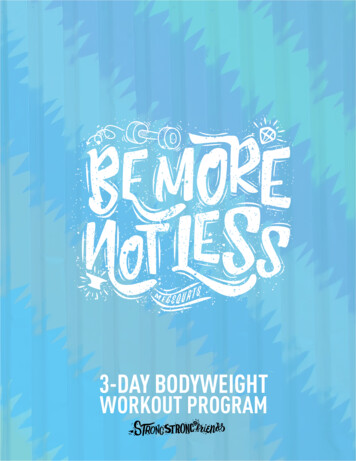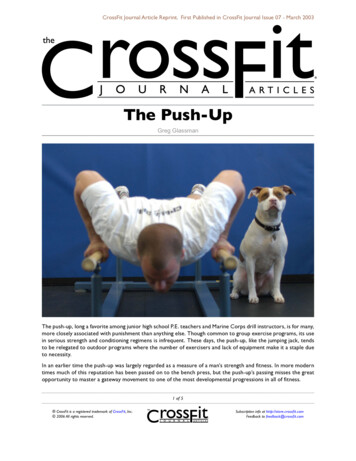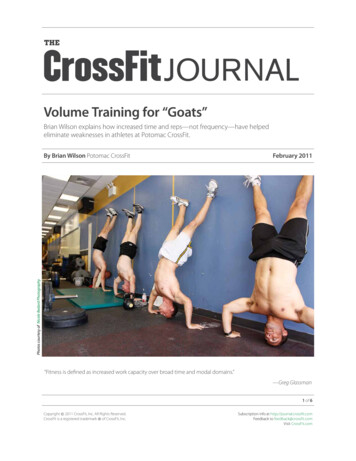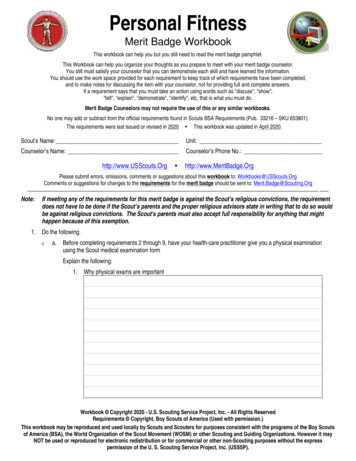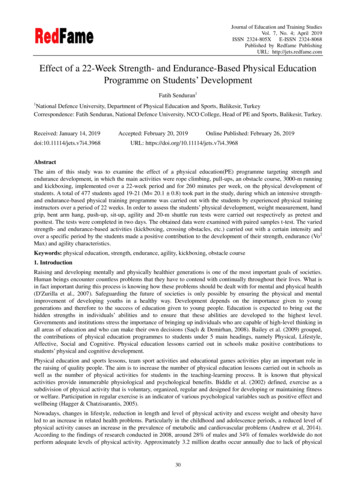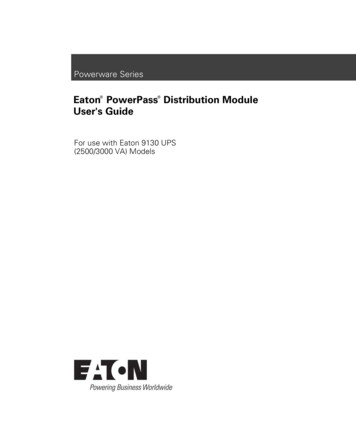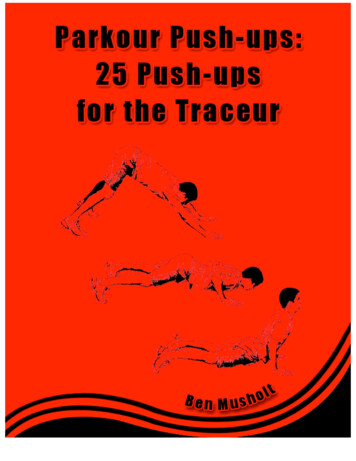
Transcription
Parkour Push-ups: 25 Push-ups for the TraceurBy:Ben MusholtVersion 1.0Copyright 2012 Ben MusholtAll rights reserved.This work is licensed under Standard Copyright License. No portionof the work may be reproduced without consent of the author.Author can be contacted at: parkour.bpm@gmail.com.Any physical activity has an inherent risk of injury, including bodilydeath. Before beginning any exercise routine, including the exercisesillustrated in this book, please seek medical clearance from aphysician or other licensed medical professional. The author wishesyou to have fun in your pursuit of your fitness, but please: Be safe!
IntroductionIt’s safe to say that everyone is already familiar with the push-up as akey movement in the pursuit of physical fitness. It is widelyrecognized as the “king” of body-weight exercises, for its puresimplicity, as well as the variety of different ways it can be performed.As a parkour practitioner, you’re undoubtedly already incorporatingpush-ups into your strength and conditioning routine. The goal ofParkour Push-ups is to introduce you to 25 new varieties of push-ups,which should have a positive impact on your training andperformance.The rigors of being a traceur place a high degree of stress on yourbones, joints, and musculature. It’s essential to condition your body tothe multiple jumps, sprints, rolls, and occasional crashes, that youencounter while out running. If you only ever performed an exercisein a single plane of movement, you’d never provide the type of varietythat your body needs to be prepared for the unexpected ways it mustmove when being athletic. The 25 push-ups highlighted in this ebook will force you to try different hand positions, different angles ofyour torso, and even suggest some basic equipment that you canuse. The different push-up positions will help condition yourshoulder, elbow and wrist joints, to a variety of different stressors.By themselves, push-ups are a great way to train upper body andcore strength, but they certainly do not constitute a complete fitnessregimen. To remain a healthy and strong traceur, it’s critical that youalso perform targeted lower body, back, and abdominalstrengthening. Don’t forget the need to perform dynamic warm-ups,joint mobility, and stretching as needed before and after yourworkouts.I hope you find these 25 push-up variations helpful. If you like them,be sure to look for Parkour Conditioning, which highlights over 150movements for whole body strength and flexibility.
The Push-upsThe fingertip push-up introduces a unique element to the push-uptriad of chest, shoulder and triceps strength: finger strength. It’spretty self-explanatory, really. Instead of resting palms down on theground, elevate your hands on extended fingers. Maintain thisposition through out the upward and downward cycle of the push-up.Impress your friends.
The “wide push-up” is just as the name implies — a push-up with thehands placed far apart. Assume a plank position, and then spreadyour arms out as far as you comfortably can. Complete the push-upby lowering your chest to the ground, then pressing back up to theplank position, while staying tight through your trunk and hips. You’llnote that you have less vertical motion with this variation, but it reallyworks the chest, like no other!
The “narrow grip push-up” is extremely closely related to what iscommonly known as a “diamond push-up”, but I think it deservesmention as a stand-alone variation. Don’t worry about inwardlyrotating your hands to connect thumb and index finger. Position yourhands under your chest, at approximately nipple level, with yourfingertips pointed toward your head. Meet one of your new favorites!
To perform the “overhead push-up,” place your hands on the groundat a place above shoulder height and ideally higher than your headposition. If you are strong enough to drop all the way down to theground and back upwards, congratulations, you are a rare breed.These full overhead push-ups have sometimes been referred to as“Chinese push-ups.”
And now: the “plyo push-up”, also sometimes affectionately referredto as “clapping push-ups.” For whatever reason, these push-ups arealways a crowd favorite — a sure way to spice up a boring workout.The word “plyo” is short for “plyometric”, which is fitness speak for anexplosive movement that is preceded by a quick stretch. Start by justpushing up hard and fast enough that you can lift your handscompletely off the ground. Once you’ve got that mastered - add theclap. Bring your hands together to make some noise, prior todropping back down to the starting position.
“Triple stop push-up” aren’t anything fancy; you just add a pause priorto completing the bottom and top movements. Start in a plankposition, lower halfway, pause, continue to the bottom, hold, push-up,pause halfway, and then finish back where you started. Easy right?Hmmm. The two step lowering and raising motion sure does seem todouble or triple your effort, and certainly makes you complete thepush-up slower, which can be brutal by itself. I think for best effect,it’s nice to do these movements as a group, so that people can suffertogether at the multiple hold points.
Find a park bench or stairway that you can use for this push-up. Flipthings around so that your feet are supported above your chest.There you have it: the “decline push-up.” This is the first push-upvariation we’ll get to that actually is beginning to place more of apercentage of one’s body-weight onto the shoulders. More bodyweight means heavier and thus that these variations are harder toperform. Oh boy, now we’re starting to have fun!
The famed “one arm push-up” — a lot rides on this one! The ability tocomplete this movement separates the true body-weight athletesfrom the posers. So, what’s the trick? To do this variation effectively,you need to position your hand on the ground at chest level andmidway between your shoulders. You’ll note that as you drop down,the hand feels quite internally rotated, and your elbow sticks out tothe side more than on regular push-ups. That’s normal. Make sure todo both sides for strength symmetry!
The “pike push-up” builds on the decline push-up that was justintroduced, but given the placement of your hands it begins toselectively strengthen the shoulders more so than the chest.Consider it a preliminary movement to taking the push-up completelyinverted. To perform this skill, place your hands slightly higher thanshoulder height, then stick your bottom in the air. Drop your headdownward to the ground to a target between your hands, then pushback upward along an angle. Make sure to breathe with this one!
Ahh, one of my personal favorites: the “dive bomber push-up.” Thisis a brutal variation because each time you do a full set you areessentially lifting your weight twice. To perform it, start in the pikepush-up position illustrated earlier, then drop your chest down andbetween your hands. Next, you’ll keep your momentum going forwardand begin to rock upward into a position they call “upward dog” inyoga practice. You’re halfway done. Finish the push-up by rockingdown and backward, bringing your chest to the ground again, andthen back upward to the starting pike position. You’re going to lovethese, I promise.
Now we’re starting to have fun! The “jackknife push-up” is the firstvariation in which the body is in a truly inverted position in relation tothe ground. By placing your feet on a chair or bench however, youare able to provide a degree of stability and take a fraction of theweight off, from doing a completely unsupported upside-down pushup. This movement is extremely intense on the shoulders, and youmust pay attention to your fatigue level so that you don’t bang yourhead on the ground. Other than that piece of advice, it is fairlystraight-forward to perform. Assume the position shown above, thenlower your head gently to the ground, and press back up to thestarting position.
To do the “uneven push-up” shown above, you’ll need a medicine ballor any other stable surface that can support a portion of your bodyweight. Get creative - try a few of books, a stair, or even a stack ofweight plates. The goal is to have one arm elevated on a surface,with your other hand flat on the ground. By using your hands in thisposition, you differentially load one shoulder/chest complex more sothan the other side. You need to alternate sides after a few reps, tomake sure that you get an even workout, but trust me, these beautieswill leave you sore the next day. They look easy, but are surprisinglychallenging.
So far we’ve played with varying your hand position on the ground,and the angle of attack for your chest in relation to the ground. Forthis variation, all you have to do is hold one leg up behind you, in theair. Should be pretty simple, but what you’ll quickly find out is that it’sa bit of a balancing act, and actually makes the push-up harder thanyou would anticipate. Again, you’ll want to switch legs after ten repsor so, to get a symmetrical workout.
Parallettes are training tools used by gymnasts to work on upperbody strength. You can make yourself a pair with PVC tubing orregular metal pipes, or you can purchase a pair online from 50 to 100. So, what’s cool about them? Well, because you are slightlyelevated off the floor surface, you can achieve a deeper degree ofmotion, than if you were doing a regular push-up on the ground.They are great tools to work a full range of motion, and it’sguaranteed that you’ll more sore than you expected afterwards.
Next up: the “staggered push-up.” To do this push-up variation youdon’t need any props, all you have to do is place your hands on theground in a staggered alignment. Try one hand just forward of yourshoulder, and the other hand just below your nipple line. You can alsoplay with having one hand far out to the side, and the other tuckedclose to your body. The idea is to keep your body and musculatureguessing with regards to how it has to move to perform the push-upmotion. Make sure to mix things up after a few reps, so that bothsides get an even workout.
To do a “cartwheel push-up” place both hands on the ground, and liftone leg up, as if you were going to kick over into a full cartwheel.Now, drop your head to the ground slowly, and press back upwards.The movement should feel like an asymmetrical pike or jackknifepush-up. Switch sides after a number of reps, so that both shouldersget an even burn.
The “drop push-up” is a variation of a plyometric push-up, in whichyou explode upwards from the floor, to place both hands on boxes orstacks of books that are positioned on both sides of our body. Fromthe boxes, you push-off again to drop to the ground, catching yourbody weight on your palms. Back and forth, up and down you go.These must be performed rapidly, and with attention to handplacement, so that you don’t slip off the box and twist a wrist.
To begin a “rotated push-up” you must assume a rotated plankposition on the floor. Start off in a side plank, with one foot/legstacked sideways on the other, and then reach your top hand to theground into a push-up position. It’s as if your lower body is holding aside plank, while your upper body is in the push-up position. Try tokeep your head rotated to the side however, through out the motion.You should feel how this movement places an uneven strain on theshoulders. Switch sides as needed.
I know you’ve been waiting for this one, here it is: the elusive“handstand push-up”. If you’ve been following along so far, youshould have already been introduced to a series of preliminaryvariations to get you strong enough for this difficult movement. Buildup to a full on handstand push-up with decline push-ups, pike pushups, and then jackknife push-ups. Once you feel confident that youcan safely perform this skill, kick up to a handstand against a wall forsupport. Lower your head to a target between your hands, then pushback up to full elbow extension. Sounds so easy, but alas it’s not!
Unless you’ve been trained as a gymnast, my guess is that you’venever seen this push-up variation before. It is called a “semi-planchepush-up” and entails placing your hands on the ground, with yourfingers rotated backwards, pointing to your feet. You lower yourchest to the ground from this position, and then return to the start. Ittakes some special wrist flexibility for sure, but once you get the hangof it, it’s an awesome variation to spice things up.
The “breakdance push-up” stems from a capoeira movement, calledthe “queda do rins”, or “fall to the kidneys.” To complete this move,start in a low squat position then gently dive forward onto you palms,bringing one side of your body to rest on a single elbow. You pushback to the squat position, then dive off to the opposite side, comingto rest on the opposite elbow. Back and forth, side-to-side these arewicked push-ups, requiring significant strength and balance.
Let me introduce you to one of your new favorite push-up variations:the “scorpion push-up.” This push-up begins like a regular push-up,or if you like, as a single leg push-up. As you drop to the groundhowever, you whip one leg back and over to the side, like ascorpion’s tale. The effect of this motion is that it loads one shouldermore than the other. You can either switch legs on every movement,or do 10 repetitions and then switch sides. Love these.
Continuing in the theme of asymmetric push-up variations, here youhave the “T push-up.” Start this variation in a semi side-plankposition, with one arm elevated above your chest, then lower down tothe ground. Push back to the “T” twist position, and repeat. Tryswitching sides on each repetition. If you have access to them, youcan also try these push-ups while holding small dumbbells in eachhand.
The “spiderman push-up” won’t help you climb buildings like asuperhero. wait a second, maybe it will! Start in a single leg push-upposition, then drop to the ground, while simultaneously bringing theknee of the elevated leg to nearly make contact with your elbow ofthe same side. As you drop to this bottom position, play with turningyour head to that same side, for a bit of trunk rotation. I’d suggestalternating sides with each repetition, but you can certainly attempt abunch on one side, before alternating.
Ready for a serious challenge? Try the “backbend push-up!” Justgetting into the starting position is a feat in itself. Start on your back,with your knees bent, and hands positioned up by your shoulders.Press up into a classic yoga backbend (or “wheel”) position. Hold itfor a second, then allow your elbows to bend, so that you lower yourhead to the ground. Be gentle - don’t give yourself a head or neckinjury! Press back to the full backbend position, and repeat to fatigue.It’s a good idea to keep your abdomen and glute (butt) musclescontracted, to protect your low back, which can take a lot of strain inthis position.
ConclusionYou made it! Hopefully a few of 25 push-ups were ones that youhadn’t seen or tried before. I’d encourage you to switch up the pushups you do on a daily basis, rotating randomly through the list I’veprovided above. Don’t get stuck doing the same conditioning routinedaily. Challenge your body to move in unique ways all the time, afterall - that’s what you’re doing with parkour anyway, right?If you liked the images that you were introduced to, I’d encourage youto check out my blog: Strength Mob. I post garage workouts overthere about twice a week. They typically finish with a different pushup variation each session, and will often introduce you to new ways toperform barbell, kettlebell, and body-weight movements.Likewise, as I mentioned in the introduction, you should pick-up acopy of Parkour Conditioning. I guarantee that you will find some legconditioning, core strengthening, warm-up, and stretching ideas, tohelp to improve your parkour training.Best of luck in your training and stay fly!
The Push-ups The fingertip push-up introduces a unique element to the push-up triad
